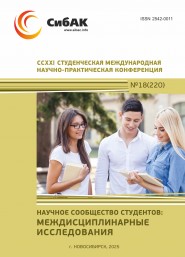Статья опубликована в рамках: CCXXI Международной научно-практической конференции «Научное сообщество студентов: МЕЖДИСЦИПЛИНАРНЫЕ ИССЛЕДОВАНИЯ» (Россия, г. Новосибирск, 25 сентября 2025 г.)
Наука: Сельскохозяйственные науки
Скачать книгу(-и): Сборник статей конференции
дипломов
THE USE OF DRONES AND SATELLITE DATA FOR PRECISION FARMING
ABSTRACT
The article examines current trends in the use of unmanned aerial vehicles (drones) and satellite technologies in agriculture in Russia. The role of precision agriculture as a key area of digital transformation of the agricultural sector is shown. The possibilities of using drones and satellite data to monitor the condition of crops, apply fertilizers and plant protection products, and predict yields are analyzed. Special attention is paid to the Russian realities: the availability of domestic developments, government support and restrictions related to the import dependence of technologies. Additionally, the prospects of using small satellites (CubeSats) in the agricultural sector are being considered. It is concluded that it is necessary to actively implement digital solutions to increase the efficiency and sustainability of agricultural production.
Keywords: precision agriculture, drones, satellite data, CubeSat, agriculture in Russia.
Agriculture, as one of the key sectors of the global economy, is facing growing challenges related to climate change, an increasing global population and the need to ensure food security. Traditional agricultural research methods, despite their effectiveness, are not always able to cope with the volume and complexity of data needed to make informed decisions.
Agriculture has traditionally been one of the key sectors of the Russian economy, ensuring the country's food security and its export potential. However, in the context of climate change, increasing competition in global markets and the need for rational use of resources, the role of modern technologies in agricultural production management is increasing. Precision agriculture based on the use of drones and satellite monitoring systems is one of the most promising areas [1, p. 693].
Drones have become an indispensable tool for farmers in recent years. Their main functions include: monitoring the condition of crops using multispectral cameras, mapping fields to analyze soil heterogeneity, precise application of fertilizers and plant protection products, which reduces costs by up to 30%, monitoring irrigation and identifying areas of waterlogging and drought.
Satellite remote sensing systems provide data on the state of soils and plants in large areas. Their use makes it possible to monitor vegetation, predict yields, assess climate risks, and plan agricultural production processes [2].
National satellite groupings (Canopus-V, Resurs-P) are actively developing in Russia, and work is underway to integrate data from Roshydromet into agricultural services.
The prospects for the introduction of precision farming technologies are related to the expansion of drone capabilities and the improvement of satellite systems. An important area is the use of small CubeSat satellites, which have a relatively low cost and can be launched by whole groups. Such satellites are capable of providing high-frequency data on field conditions, weather conditions, and soil changes. Unlike traditional satellites, CubeSats provide faster information updates and accessibility to a wide range of users [3].
There is an increase in activity in the field of creating CubeSat groupings for monitoring agriculture in the world. Russia is also interested in developing small satellites, which can give a significant boost to the development of precision agriculture and reduce dependence on foreign data.
Digitalization of agriculture is part of the government's agribusiness development strategy. Pilot projects on the introduction of precision farming technologies are being implemented as part of the Digital Economy national project and the Digital Agriculture program.
The use of drones and satellite data in agriculture opens up significant prospects for Russia, which has one of the largest farmlands in the world. This allows for more efficient management of large territories, rapid identification of problem areas and optimization of resource use [4].
Despite the obvious advantages, the process of introducing digital technologies into the agricultural sector faces a number of serious challenges. One of the key problems remains the high cost of equipment and services, which makes them inaccessible to small farms. Russia's dependence on imported technologies is also an important limitation: many drone components, satellite sensors, and software are manufactured abroad. An additional risk factor is the shortage of specialists with competencies in the field of agro-digitization, which makes it difficult to widely disseminate innovations in practice.
In the coming years, the active development of domestic solutions in the field of precision farming is expected. Work is already underway to create Russian drones for agriculture and satellite data processing services, which will reduce dependence on foreign technologies. Of particular interest is the formation of national CubeSat groupings, small satellites that can provide farmers with operational and highly accurate information about the state of crops and soils. These technologies will create the basis for a comprehensive digital transformation of the agricultural sector, making it more sustainable, productive and independent.
The use of drones and satellite data in precision agriculture opens up broad prospects for Russia. These technologies can significantly increase the efficiency of agriculture, reduce costs, improve the environmental situation and strengthen the country's food security.
References:
- Zhang, C., Kovacs, J. M. The application of small unmanned aerial systems for precision agriculture: a review // Precision Agriculture. – 2012. – Vol. 13, №6. – P. 693–712.
- FAO. The State of Food and Agriculture 2021. – Rome: Food and Agriculture Organization of the United Nations, 2021.
- ESA. Earth Observation for Agriculture. – Paris: European Space Agency, 2022.
- National Research University "Higher School of Economics". Analysis of the use of UAVs in Russian agriculture. Moscow: HSE, 2023.
дипломов


Оставить комментарий